Forestry organizations, businesses, and communities celebrated Wisconsin’s diverse forest products sector during National Forest Products Week on October 15-21, 2017. Gov. Scott Walker also proclaimed the week as Forest Products Week in Wisconsin, encouraging citizens to recognize the many products that come from our forests because of the people and businesses that work in and care for forests. Several forest products businesses and organizations hosted open house events throughout the week. DNR produced a new handout to showcase the economic value of Wisconsin forests. If you’d like copies of this printed publication, send an email to DNRFRPublications@wisconsin.gov noting your street address, the number of copies you’d like and the publication code number (FR-698). Continue reading “Forest products celebrated”
Year: 2017
Architecture students use Wisconsin’s underutilized wood species as mass timber
Over the summer, Forest Products Specialist Scott Lyon had the opportunity to provide technical assistance in sourcing wood materials and product development for a summer immersion program at the School of Architecture at Taliesin in Spring Green. The immersion program is geared to college-level participants and adults interested in deepening their understanding of the architectural discipline, this experience provides an opportunity to learn about architecture side-by-side with faculty and students at the Frank Lloyd Wright School of Architecture. Continue reading “Architecture students use Wisconsin’s underutilized wood species as mass timber”
Wood construction seminar was a success
On September 20 , 2017, the Forest Products Services Program, in partnership with Forest Stewards Guild, American Institute of Architects, Structural Engineers Association, and the Wisconsin Wood Marketing Team (USDA Forest Service), organized and hosted an educational seminar titled, “Wood-Based Construction – Mass Timber and Beyond.”
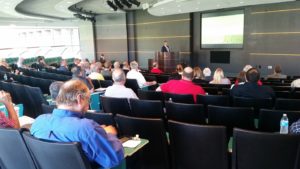 Approximately seventy people attended the event including architects, structural and civil engineers, forest products industry representatives, and researchers. Architects and engineers were targeted for this seminar due to their role in planning, designing, reviewing construction projects, and using of building materials (e.g. wood and mass timber products).
Approximately seventy people attended the event including architects, structural and civil engineers, forest products industry representatives, and researchers. Architects and engineers were targeted for this seminar due to their role in planning, designing, reviewing construction projects, and using of building materials (e.g. wood and mass timber products).
Forest products news and events
- Grant Opportunity: US Forest Service to award $7 million in grant applications for projects that expand wood products and wood energy markets. Find details here.
- Hoppe’s Urban Wood Lab Store takes a sustainable and local approach to lumber and wood products by partnering with Brown Deer High School to utilize urban wood. Read more here.
- Lake States Lumber Association, 2018 Winter Meeting, January 17-19, 2018, Paper Valley Hotel in Appleton; Registration information here.
- Wisconsin Local-Use Dimension Lumber Grading Workshop on February 27, 2018 at the DNR Service Center in Rhinelander.
- Thermally-modified wood (TMW) produces sustainable value-added wood products with extended service-life, and reduced environmental impacts. Read more about this product and professional consumer perceptions about Thermally-Modified Wood.
Six new counties quarantined for EAB
Since the August newsletter, it was announced that six new counties would be quarantined for emerald ash borer (EAB). The find in Chippewa County was due to a vigilant landowner while the other finds were due to trapping by USDA APHIS.
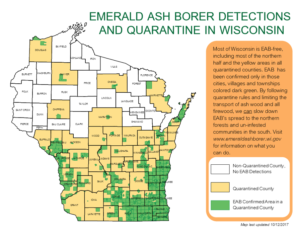
WI counties quarantined for EAB (DATCP). Most of Wisconsin is EAB-free, including most of the northern half and the yellow areas in all
quarantined counties. EAB has been confirmed only in those cities, villages and townships
colored dark green.
Look for next year’s gypsy moth infestations
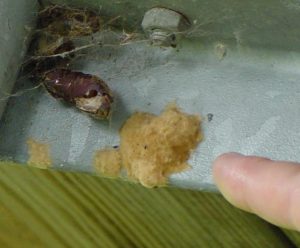
Gypsy moth egg mass
Early fall is the best time for property owners to determine whether gypsy moths will be a problem next year. Gypsy moth egg masses are tan-colored and about the size of a nickel or quarter. Egg masses will not hatch until next spring, which means landowners have plenty of time to plan to minimize gypsy moth damage next summer. New egg masses produced this year feel hard, whereas those that are older are soft and appear faded. Most egg masses will be found on tree trunks and the undersides of branches, but they can also be found on buildings, firewood piles, vehicles and other outdoor objects.
Continue reading “Look for next year’s gypsy moth infestations”
New video on buckthorn control available
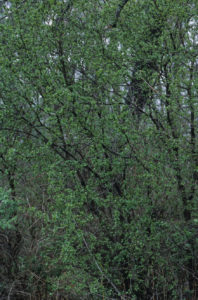
Common buckthorns retain leaves late into the fall.
The following article offers a glimpse of the good work that happens after DNR awards grants through its Weed Management Area – Private Forest Grant Program (WMA-PFGP). Dick Ballou, the driving force of the Cedar Lake Buckthorn Project, takes us through his efforts to raise awareness of that forest scourge -common buckthorn- and control its spread. The next application deadline for WMA-PGRP grants is April 1, 2018. More information on applying for the grant can be found here.
Imagine the frustration of eagerly awaiting your opening day of deer hunting, having your stand in a perfect location and learning at daybreak that the woods around your stand are not as you expected? Several years ago, I prepared for bow hunting and found a perfect location for the deer stand, except for one small problem, a 20-foot tall tree full of leaves. Thinking the tree’s leaves would be gone by mid-October, I placed the stand nearby and went home. Returning in October, the “perfect” location was seriously compromised by the same tree – full of leaves – obstructing my view. Later, I learned the tree was invasive common buckthorn that currently threatens woodlots from New England to Wisconsin and beyond. This experience led me to start the Cedar Lake Buckthorn Project and create this video on buckthorn control. Continue reading “New video on buckthorn control available”
Winged ants
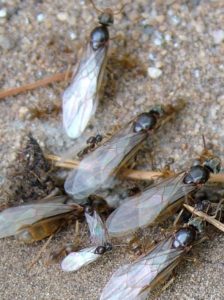
A mass emergence of winged ants. Photo by Mike Kamke.
On August 29, and again in early September, a mass emergence of winged ants occurred in southern Vilas County and some areas of northern Oneida County. Mass emergences of winged adults are part of a reproductive strategy used by ants to overwhelm predators, in the hope that a few of the new queens will mate and establish their own nests. When weather conditions are right, winged individuals from many ant colonies in an area will emerge and fly away to mate and start their own nests.
Winged ants consist of large winged females and smaller winged males, but many folks that reported these insects were concerned that they were seeing swarms of wasps since most people aren’t accustomed to seeing ants with wings. Once new queens and males fly away from the nest, they will eventually drop to the ground, shed their wings, mate and start a new nest. These events are relatively rare for folks to see as they are very short lived, with the winged ants generally being gone within a day.
Oak wilt continues to be found in the north

In this photo two oak trees have died from oak wilt (yellow dots). One tree is currently wilting and dropping its leaves (purple dot).
In August, I reported that we’d found oak wilt in Cloverland Township in Vilas County, in Arbor Vitae Township northeast of Woodruff, (on the southern border of Boulder Junction Township), and along Nabish Lake Road in Boulder Junction and Plum Lake Townships.
So, what’s new since then? Another tree killed by oak wilt was identified on the western side of Plum Lake in Plum Lake Township in Vilas County; another tree died in Washington Township just north of the city of Eagle River. I’m still waiting on results from a suspicious tree in northern Three Lakes Township in Oneida County. In many cases spring storms, which occurred during the high-risk period for overland transmission of oak wilt, were to blame for new oak wilt infections. But in some cases, disease was due to logging or pruning that occurred during the high-risk period for overland transmission of oak wilt. It’s important to know where oak wilt is and to minimize your risk.
For more information, visit the DNR oak wilt web page.
Continue reading “Oak wilt continues to be found in the north”
Oak wilt update for Rusk, Washburn, and Sawyer counties
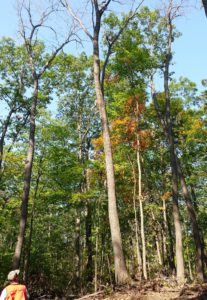
Mature northern red oaks killed by oak wilt in Sawyer County. Photo by Paul Cigan
Late-summer aerial and ground surveys revealed new oak wilt infections within northern red oak stands in Rusk, Sawyer and Washburn counties. Below is an update on the finds in each of the counties.
In Rusk County, aerial detection surveys led to the confirmation of 10 new infections on county forest property. Suspected factors for these infections include spring storm damage and latent detection of past infections caused by logging damage during unrestricted spring harvesting. The county forestry department continues to use cut-stump herbicide treatments to control below-ground transmission. They plan to continue follow-up monitoring of treated pockets and have reported encouraging results to date; only a few pockets treated between 2015 and 2016 contained newly infected oaks on or near the edge of the treatment zone.
Continue reading “Oak wilt update for Rusk, Washburn, and Sawyer counties”
